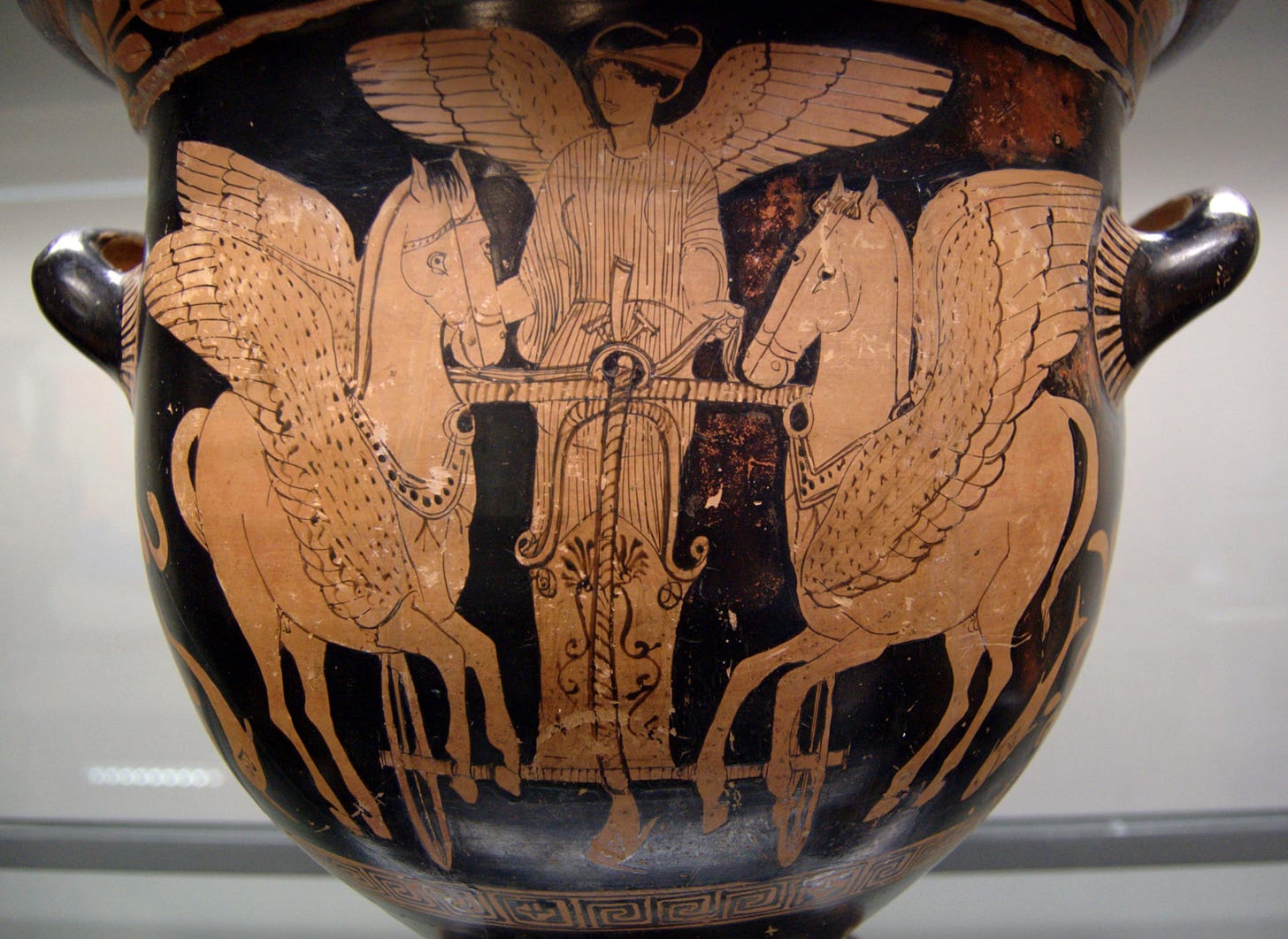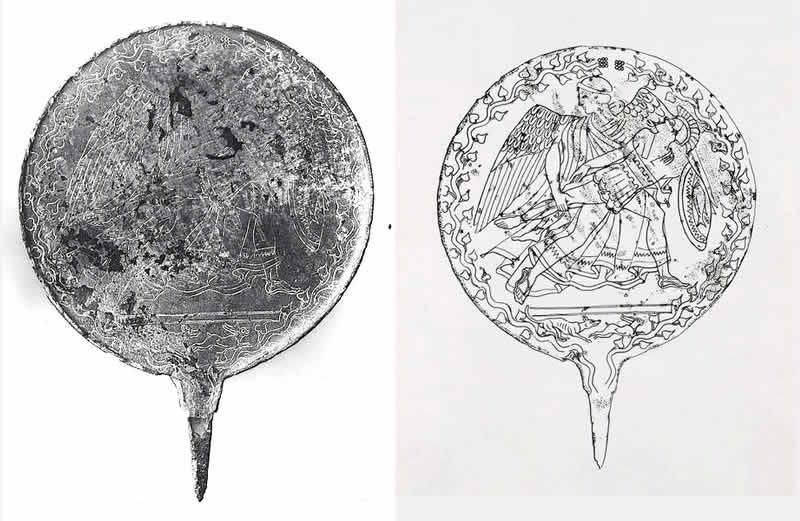Fresh Batch #110: Eos, the Most Depicted Character on Etruscan Mirrors
Library Burning, Jason, Medea, Minerva, and Queen Maeve

Richard Daniel de Puma wrote in an article titled Eos and Memnon on Etruscan Mirrors (Mur. Etr. p. 180), “Among the group of earliest Etruscan engraved mirrors (those produced between c. 530 and 450 BC), one mytholological character predominates: Eos, goddess of the dawn.”
The challenges archaeologists face cannot be stressed enough, which is why you need to avoid appealing to perceived authority. Even with a man as learned as this gentleman, the work of the archaeologist is still guessing at chronology based on other factors, and one cannot blame archaeologists for having so little to work with or draw from. De Puma wrote (Ib.), regarding an Etruscan bronze mirror, “The details also show that the artist used a square punch to enhance certain objects, a characteristic technique of early Etruscan mirrors. Considering this and other engraving techniques used on the mirror, the shape and profile of the disc, the decorative format, and the figure style, I believe that this object dates c. 470 - 450 BC.”

He continued, “The Art Institute has no precise findspot (the museum claims Vulci), but its history can be traced back to a private British collection. We may assume that it was found in an Etruscan tomb; but while we can never know with certainty, the mirror probably came from the bronze workshops of Vulci in Southern Etruria. Recent scholarship suggests that the decorative ivy border is a hallmark of Vulcian mirror designs. One unusual and distinctive feature of the Art Institute mirror is the treatment of Eos’ wings. The rounded feathers of her upper wings, each of which is engraved with a chevron and radiating lines, are precisely paralleled on the famous relief mirror from Vulci in the Vatican, and on other bronze objects associated with Vulci but now in St. Petersburg.” (Bronze appliqué reliefs of a winged deity, probably Usil, c. 500 -475 BC. See Haynes (Etr. Bron. 275-76, nos. 81-82 with additional references on p. 276. The example cited as being on the antiquities market in London is now in a private collection in Bern.)

Again (Ib. p. 181), “Many Etruscan mirrors bear inscriptions identifying the figures, but the Art Institute mirror does not. Instead, we must rely on attributes and iconographical similarities with known examples to identify the subject. The salient features are: the female is winged and, therefore, superhuman; the male is a dead or dying warrior. The most likely candidates are Eos and her son, Memnon.”
The gentleman was guessing, like all archaeologists must. This is not a critique of them. They have no other option. I’m not even suggesting the guess is incorrect. But what if it is? The point is to show you that their ideas are not set in stone. They’re guessing. I could guess too, and the figure on the Vatican plate doesn’t look like a female to me. Is a winged saint or angel, carrying what looks like a naked man, Eos carrying Memnon? Perhaps. But what if that winged figure is not a woman on the Vatican plate mirror? What myth would this be? Could it just be an artist’s allegory for the sun carrying away the dying night at dawn?
Eos, goddess of the dawn, if the artifact is her, would be from a time before the archetype Venus was ascribed to the planet, when she was an archetype or aspect of the sun at a particular time, whether it be of the day or of the year. Notice the sun or gloriole around her head. It’d indicate that she’s an aspect of the sun at dawn, which would then be why the name Venus was ascribed to that luminary that spends so much of its time in the predawn sky. There isn’t much remaining on the myth from the times they would’ve been created, an unfortunate circumstance we must deal with on account of the texts being destroyed. Kephalos was described as a hunter, so this myth may have been created to depict the dawn carrying away Orion during the winter months, or day break taking away your view of that constellation. Apollodurus wrote (I. 27.), “Eos, whom Aphrodite tormented with constant passion as punishment for sleeping with Ares, fell in love with Orion and took him off with her to Delos.” (Translated by Keith Aldrich, The Library of Greek Mythology by Apollodorus.)
The subject of Eos with a young lover is common on Etruscan mirrors in the first half of the 5th century, but not on Greek mirrors. It was however, frequent on Greek pottery. There was no cult dedicated to her in Greece but the Etruscans allegedly revered her. De Puma wrote (Ib. p. 187), “Significantly, almost all of the Greek vases illustrating Eos pursuing or abducting a lover come from Italian, especially Etruscan, sites. This may mean that Greek vase-painters were aware of an Etruscan penchant for this subject and, therefore, decorated their vases accordingly. This would not be the only instance of their willingness to meet the specific demands of a foreign market.”

De Puma’s observation aligns with my suspicions, that much of the things attributed to Greek history is the misunderstanding and erroneous dating of Italian history, which is Etruscan and Phoenician history. We know Adonis is a Phoenician deity and the Old Testament is replete with allusions to him, calling God my lord, or Aduni. This is likely where some of the confusion of Phoenicians being Jews came from. But as learned men have demonstrated, the vehicle of the Old Testament is Greek, not Hebrew or Chaldean. The Greeks took the Phoenician mythology and repurposed it for their own culture according to Bishop Thirwall and Betham. I bring this up because on the same page, De Puma wrote, “After c. 450 BC, when depictions of Eos on mirrors decline in popularity, she is replaced by comparable scenes of Aphrodite and her lover Adonis. Some of these are so similar that only inscriptions assure us that the goddess is Eos rather than Aphrodite, and the lover is Tithonos rather than Adonis.”
De Puma thought it was possible that the decline of Eos’ popularity was a result of military defeats alluded to by Diodorus Siculus in Bibliotheca c. 60 - 30 BC, which I will remind you is centuries later and not likely possible for it to be accurate.
And in this year [474 BC] Hieron, the king of the Syracusans, when ambassadors came to him from Cumae in Italy and asked his aid in the war which the Tyrrhenians [Etruscans], who were at that time masters of the sea, were waging against them, he dispatched to their aid a considerable number of triremes. And after the commanders of this fleet had put in at Cumae, joining with the men of that region they fought a naval battle with the Tyrrhenians, and destroying many of their ships and conquering them in a great sea-fight, they humbled the Tyrrhenians and delivered the Cumaeans from their fears…
[The Syracusans dispatched Apelles, an admiral] with sixty triremes against the Tyrrhenians. [In 453 BC] he overran the coast of Tyrrhenia and then passed over to Cyrnus [Corsica] which was held at those times by the Tyrrhenians, and after sacking many places in this island and subduing Aethaleia [Elba], he returned to Syracuse accompanied by a multitude of captives and not a little other spoil…
If the Etruscans were masters of the sea, which are Thalassocrats, how are they losing naval battles to Syracusans from Sicily? Did they not have this region of the Mediterranean locked down at the time so that no neighbor could usurp them?
The following mirror is much easier to interpret because their names are written in Etruscan: Memnun (Memnon) and Achle (Achilles). Eos’ name in Etruscan is Thesan according to other mirrors. She’s corroded but you her head and wing is revealed just to the right of Memnun’s head. The provenance of this mirror is unknown but it was at the New York Metropolitan Museum of Art, Rogers Fun 22.139.84. It is from c. 460 BC, centuries older than the oldest Indian inscription. It is bizarre how the alleged female archetype is depicted with short hair. At the bottom of the mirror are the angel figure’s feet (one is beneath Memnon’s sword, held in his right hand, the other beneath his right knee). The shoes have wings, just like the messenger of the gods, Hermes Mercury. The Etruscan version is Turm, sometimes Turms or Thermes. Is it possible that it is the god of death, of the underworld, the guide of the manes or the newly departed souls, is Turm and not Eos/Thesan as believed? This could then be an allegory for day and night, or for the battle between the two halves of the year of summer and winter, heaven and hell, divided by the boundaries at the spring and autumn equinoxes.
The Mirror of Piansano, now in Copenhagen, has a fish depicted on Memnon’s shield, should it be him. The constellation Pisces used to be called Venus et Cupido (Venus and Cupid). Is this a precursor to that? The Bishops were called Little Fishes (Pisciculi). We know Dagon references a fish (dag) and another name for Buddha was Dag-Po. I’m not ready to make a claim about this, I just wanted to put it on your radar for reference.
Here’s where De Puma’s ideas parallel with my work. He wrote (Ib. p. 181), “If one examines all the known Etruscan engraved mirrors from this early phase of production, c. 530 to 450 BC, some interesting points emerge. There are three main subject categories: mythological; Dionysiac (mainly satyrs and maenads); genre (e.g., musicians, dancers, banqueters, or atheletes). Of these, the most numerous are the mythological scenes, and, significantly, it is Eos who is shown more frequently than any other character. Eos, either alone or in the company of Memnon or a lover, is not a common subject on mirrors after c. 450 BC, even though mirrors were produced in greater quantity then. How can we explain her popularity on mirrors between c. 530 and 450 BC in Etruria?”
Become a member to see the rest of this article.
Keep reading with a 7-day free trial
Subscribe to Ancient History, Mythology, & Epic Fantasy to keep reading this post and get 7 days of free access to the full post archives.






